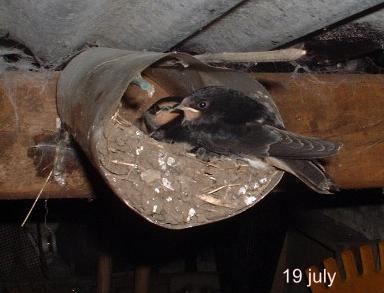Swallow
Scientific name: Hirundo rustica
Other name: Barn Swallow


Here the swallows built a nest in a plastic tube made from a drinks bottle to protect young plants and stored in the roof beams of the potting shed. The difference between the two pictures is 10 days. By the time the second picture was taken they had started to fly.
Swallows are summer visitors to our shores, migrating thousands of miles in spring, from southern Africa. From a distance they appear to be black with a white breast, but up close the dark feathers have a metallic blue sheen and a russet throat sits above their cream belly. They have two long tail streamers - shorter on the female - which help to distinguish them from House Martins. They feed on the wing, swooping low over meadows scooping up flying insects in their gaping mouths.
During their summer visit they take the opportunity to breed. Both adults construct a nest by mixing mud and plant fibres with their saliva and sticking it to roof beams or under overhangs on buildings and cliffs. Some refurbish nests from previous seasons and the same nest can survive for many years. The nests have been given great reverance in South-east Asia and have had medicinal and culinary uses for centuries - claims are made for slowing the ageing process, producing beautiful babies, stimulating the appetite and aiding digestion to name but a few. There is also the famous bird's nest soup.
The female lays an egg per day making a clutch of about 4, and incubates them herself. The eggs are white with red speckles and about 20 by 14mm. Both adults feed the hatchlings on regurgitated insects. They also clean out the nest by flinging the faecal capsules produced by the youngsters to the ground below, creating a stinking mound. If they choose a shed or overhang near you, it is advisable to place something below the nest to catch it. After feeding for about 12 to 14 days the young start to leave the nest returning at night to roost for a few more days then they are gone.
By late summer they start to gather in large flocks and perch in reed beds, or more noticeably on telephone and electricity wires. They sometimes perform aerial displays together as they gather for the night, climbing to great heights and swooping down in unison. By the end of September most have left on their long journey back to the south.
Back to GARDEN CREATURES
